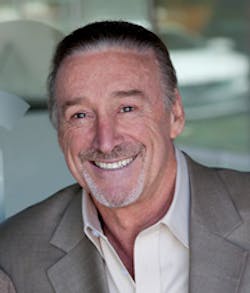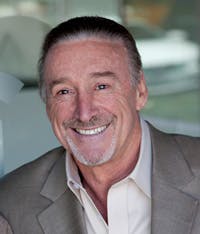Interview with Dr. Tom Hirsch from Isolite Systems
by Jeffrey B. Dalin, DDS, FACD, FAGD, FICD
Dr. Dalin: Dr. Tom Hirsch is a practicing dentist and one of the coinventors of the Isolite System. First, Dr. Hirsch, let's talk about Isolite. Many different systems through the years have tried to accomplish easy isolation of a quadrant. Your system is the first I can remember that added light to the equation. Please talk about how you developed the concept of this product, and how Isolite is different from other systems.
Dr. Hirsch: Jeff, the Isolite concept started in 1984 when fiber optic handpieces were first introduced to the market. I have always prided myself on being on the cutting edge of technology, so my brother, Jim, and I developed a new way of lighting the mouth. Nobody had ever put an illumination device inside the mouth that virtually eliminated shadows. With Isolite, we don't just project light from one point; we get the light to flood the mouth with 180 degrees of "wrap-around lighting."
The second part of the inspiration was the concept of isolation. The old gold standard of dental isolation was the rubber dam. While this is a great device, it is cumbersome, time consuming to place, and has limitations when preparing subgingival restorations. In fact, a majority of dentists in the United States do not use the rubber dam at all. Their main form of isolation is a saliva ejector and cotton rolls. Manual suction and retraction do little to control oral humidity. Isolite and the rubber dam keep oral humidity at about 43%, and with manual suction and retraction oral humidity is 98%. This is not good isolation.
So, you asked what makes us different. When I was first developing the Isolite System, I asked one of my patients for advice. After he watched me assemble the components of the system, he just stared at me and said …"one piece!" That's just one of the things that makes Isolite different.
Not only is our mouthpiece one single piece that can be placed in seconds, the other feature that makes our isolation system so unique is that Isolite mouthpieces come in a variety of anatomically correct sizes. Our mouthpieces range from pediatric to large and everything in between so that you can have easy, effective isolation for every patient and for every procedure.
Dr. Dalin: I like how you talk about better isolation giving you better dentistry. Of course, this is something dentists strive for. But how does your system result in faster dentistry? Also, how can having the system affect a practice's ROI?
Dr. Hirsch: I would love to address the ROI. This impacts many different levels. I would say that if a dentist is using the rubber dam, it takes about five minutes to punch, place, floss, and invaginate the dam. This assumes that the dam does not tear and need to be replaced. There are those who use the "split dam" technique, claiming that they can put one on in a minute. But for me this really is not isolation. Isolite can be placed in the mouth in three seconds, and away you go.
Once you have the quadrant isolated, the drilling begins. Since Isolite gives you tongue and cheek retraction and evacuation, the dentist/hygienist does not have to worry about the tongue or cheek getting in the way but can concentrate on the tooth or teeth being prepared. We know that when we stop drilling, the patient wants to sit up and rinse out. This requires the assistant to reposition the chair, wash and evacuate the mouth, give the patient a cup to rinse with, and then reposition the chair. Not to mention, the patient will ask you several questions.
Production is improved because Isolite isolates the upper and lower quadrants simultaneously. I can do opposing arch dentistry and not just quadrant dentistry. I can do two opposing crowns or fillings at the same time. My hygienist can do two quadrants of root planing in the time it took her to do one. All together, we estimate a time saving of 25% to 30% on most procedures. In some procedures, such as sealants, as much as a 50% to 75% of time saving can be attained.
That's just the first part of the ROI. What about the dental assistant? Does he or she have to be in the mouth with you at the same time? No. Since I have the patient "Isolited," my assistant does not have to retract or aspirate. The assistant is free to be a step ahead of me, setting up for the next part of the procedure. There is never any wasted time waiting for my assistant to get something out of a drawer or cabinet. In fact, my assistant is in the other room taking X-rays, study models, and photos, producing dental dollars on a different patient while I am working on my patient.
And let's not forget remakes. Do you have any idea how much it costs to remake a failed restoration? There's the cost of the restoration, the cost of the time to redo it, the materials used, not to mention the loss of confidence by the patient and the time the patient must spend. If you have to redo a restoration, and your overhead is running greater than 50% (which for most of us it is), then you, the dentist, are paying the patient to make a crown. In the world of bonded dentistry, moisture and humidity control is a must. Isolite has dramatically reduced my failure rates.
Dr. Dalin: The next advantage that comes to mind is the protection factor for patients. Explain how this is a big plus for your product.
Dr. Hirsch: I am about to make a bold statement. I am going to say that there is not one dentist in the world that has not cut a tongue or cheek at some time in his or her career. In the past 40 years of dentistry, I certainly have had my share of injuries; however, in the past 10 years with the Isolite System, I can attest that I have not cut one tongue or cheek.
In terms of the aspiration of foreign material, Isolite prevents a large number of dental accidents.
Dr. Dalin: To view a table of procedures by category, our readers can visit your website at www.isolitesystems.com/procedures.asp.
Dr. Hirsch: From sealants to implants, Isolite makes dentistry easier and enjoyable. I use Isolite for virtually every procedure in my office. Knowing that I can achieve predictable results puts my mind at ease. Not having to worry about sensitivity or bond failure makes me feel secure. Here's my list of favorite Isolite procedures -- crown preps, inlays, CEREC (CAD/CAM), fillings, bonding, cementation, implants, pedo, sealants, quad scaling, quadrant dentistry, sedation, exodontia, imaging, and intraoral photos.
Dr. Dalin: You now offer the system with light (Isolite) and without light (Isodry). I understand that some dentists prefer just the isolation and ergonomics. Are there any more improvements or new ideas scheduled to come from the company?
Dr. Hirsch: Yes! Isolite is working on many new ideas and products. At Isolite Systems, we are always working and reinvesting in our company and products to make them better for dentistry. We will be launching many new products in the next several years. I think you will find the next two new products very interesting, and we will make sure that the readers of DE are the first to know.
Dr. Dalin: Thank you for taking the time to talk about your unique and innovative product. Is there anything else you want to say to our readers?
Dr. Hirsch: As I travel around the country exhibiting Isolite, so many dentists who have outfitted their offices with Isolite stop by the booth to thank me for inventing it. They tell me how much easier and more productive I have made their dental practices. It makes me proud that I can be a part of their success, and I would like to offer a special thanks to these people.
Thomas R. Hirsch, DDS, is a founder of Isolite Systems and the creator of the Isolite dryfield illuminator. He is a graduate of the USC School of Dentistry. He served 10 years as clinical instructor of operative dentistry at USC. Dr. Hirsch practices full-time in Malibu, Calif., specializing in cosmetic dentistry and full-mouth reconstruction. You can reach him at [email protected].
Jeffrey B. Dalin, DDS, FACD, FAGD, FICD, practices general dentistry in St. Louis. He is a cofounder of the Give Kids A Smile program. Contact Dr. Dalin at [email protected].
Past DE Issues

